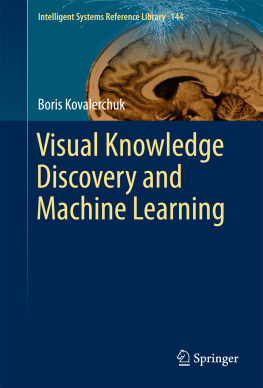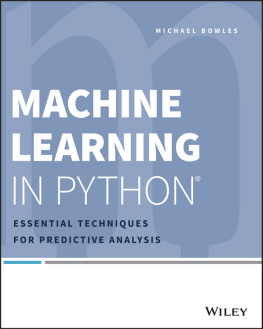Volume 144
Intelligent Systems Reference Library
Series Editors
Janusz Kacprzyk
Polish Academy of Sciences, Warsaw, Poland
Lakhmi C. Jain
The aim of this series is to publish a Reference Library, including novel advances and developments in all aspects of Intelligent Systems in an easily accessible and well structured form. The series includes reference works, handbooks, compendia, textbooks, well-structured monographs, dictionaries, and encyclopedias. It contains well integrated knowledge and current information in the field of Intelligent Systems. The series covers the theory, applications, and design methods of Intelligent Systems. Virtually all disciplines such as engineering, computer science, avionics, business, e-commerce, environment, healthcare, physics and life science are included. The list of topics spans all the areas of modern intelligent systems such as: Ambient intelligence, Computational intelligence, Social intelligence, Computational neuroscience, Artificial life, Virtual society, Cognitive systems, DNA and immunity-based systems, e-Learning and teaching, Human-centred computing and Machine ethics, Intelligent control, Intelligent data analysis, Knowledge-based paradigms, Knowledge management, Intelligent agents, Intelligent decision making, Intelligent network security, Interactive entertainment, Learning paradigms, Recommender systems, Robotics and Mechatronics including human-machine teaming, Self-organizing and adaptive systems, Soft computing including Neural systems, Fuzzy systems, Evolutionary computing and the Fusion of these paradigms, Perception and Vision, Web intelligence and Multimedia.
More information about this series at http://www.springer.com/series/8578
Boris Kovalerchuk
Visual Knowledge Discovery and Machine Learning
Boris Kovalerchuk
Central Washington University, Ellensburg, WA, USA
ISSN 1868-4394 e-ISSN 1868-4408
Intelligent Systems Reference Library
ISBN 978-3-319-73039-4 e-ISBN 978-3-319-73040-0
https://doi.org/10.1007/978-3-319-73040-0
Library of Congress Control Number: 2017962977
Springer International Publishing AG 2018
This work is subject to copyright. All rights are reserved by the Publisher, whether the whole or part of the material is concerned, specifically the rights of translation, reprinting, reuse of illustrations, recitation, broadcasting, reproduction on microfilms or in any other physical way, and transmission or information storage and retrieval, electronic adaptation, computer software, or by similar or dissimilar methodology now known or hereafter developed.
The use of general descriptive names, registered names, trademarks, service marks, etc. in this publication does not imply, even in the absence of a specific statement, that such names are exempt from the relevant protective laws and regulations and therefore free for general use.
The publisher, the authors and the editors are safe to assume that the advice and information in this book are believed to be true and accurate at the date of publication. Neither the publisher nor the authors or the editors give a warranty, express or implied, with respect to the material contained herein or for any errors or omissions that may have been made. The publisher remains neutral with regard to jurisdictional claims in published maps and institutional affiliations.
Printed on acid-free paper
This Springer imprint is published by Springer Nature
The registered company is Springer International Publishing AG
The registered company address is: Gewerbestrasse 11, 6330 Cham, Switzerland
To my family
Preface
Emergence of Data Science placed knowledge discovery, machine learning, and data mining in multidimensional data, into the forefront of a wide range of current research, and application activities in computer science, and many domains far beyond it.
Discovering patterns, in multidimensional data, using a combination of visual and analytical machine learning means are an attractive visual analytics opportunity. It allows the injection of the unique human perceptual and cognitive abilities, directly into the process of discovering multidimensional patterns. While this opportunity exists, the long-standing problem is that we cannot see the n-D data with a naked eye. Our cognitive and perceptual abilities are perfected only in the 3-D physical world. We need enhanced visualization tools (n-D glasses) to represent the n-D data in 2-D completely, without loss of information, which is important for knowledge discovery. While multiple visualization methods for the n-D data have been developed and successfully used for many tasks, many of them are non-reversible and lossy. Such methods do not represent the n-D data fully and do not allow the restoration of the n-D data completely from their 2-D representation. Respectively, our abilities to discover the n-D data patterns, from such incomplete 2-D representations, are limited and potentially erroneous. The number of available approaches, to overcome these limitations, is quite limited itself. The Parallel Coordinates and the Radial/Star Coordinates, today, are the most powerful reversible and lossless n-D data visualization methods, while suffer from occlusion.
There is a need to extend the class of reversible and lossless n-D data visual representations , for the knowledge discovery in the n-D data. A new class of such representations, called the General Line Coordinate (GLC) and several of their specifications, are the focus of this book. This book describes the GLCs, and their advantages, which include analyzing the data of the Challenger disaster, World hunger, semantic shift in humorous texts, image processing, medical computer-aided diagnostics, stock market, and the currency exchange rate predictions. Reversible methods for visualizing the n-D data have the advantages as cognitive enhancers, of the human cognitive abilities, to discover the n-D data patterns. This book reviews the state of the art in this area, outlines the challenges, and describes the solutions in the framework of the General Line Coordinates.
This book expands the methods of the visual analytics for the knowledge discovery, by presenting the visual and hybrid methods , which combine the analytical machine learning and the visual means . New approaches are explored, from both the theoretical and the experimental viewpoints, using the modeled and real data. The inspiration, for a new large class of coordinates, is twofold. The first one is the marvelous success of the Parallel Coordinates, pioneered by Alfred Inselberg. The second inspiration is the absence of a silver bullet visualization, which is perfect for the pattern discovery, in the all possible n-D datasets. Multiple GLCs can serve as a collective silver bullet. This multiplicity of GLCs increases the chances that the humans will reveal the hidden n-D patterns in these visualizations.
The topic of this book is related to the prospects of both the super-intelligent machines and the super-intelligent humans, which can far surpass the current human intelligence, significantly lifting the human cognitive limitations. This book is about a technical way for reaching some of the aspects of super-intelligence, which are beyond the current human cognitive abilities. It is to overcome the inabilities to analyze a large amount of abstract, numeric, and














